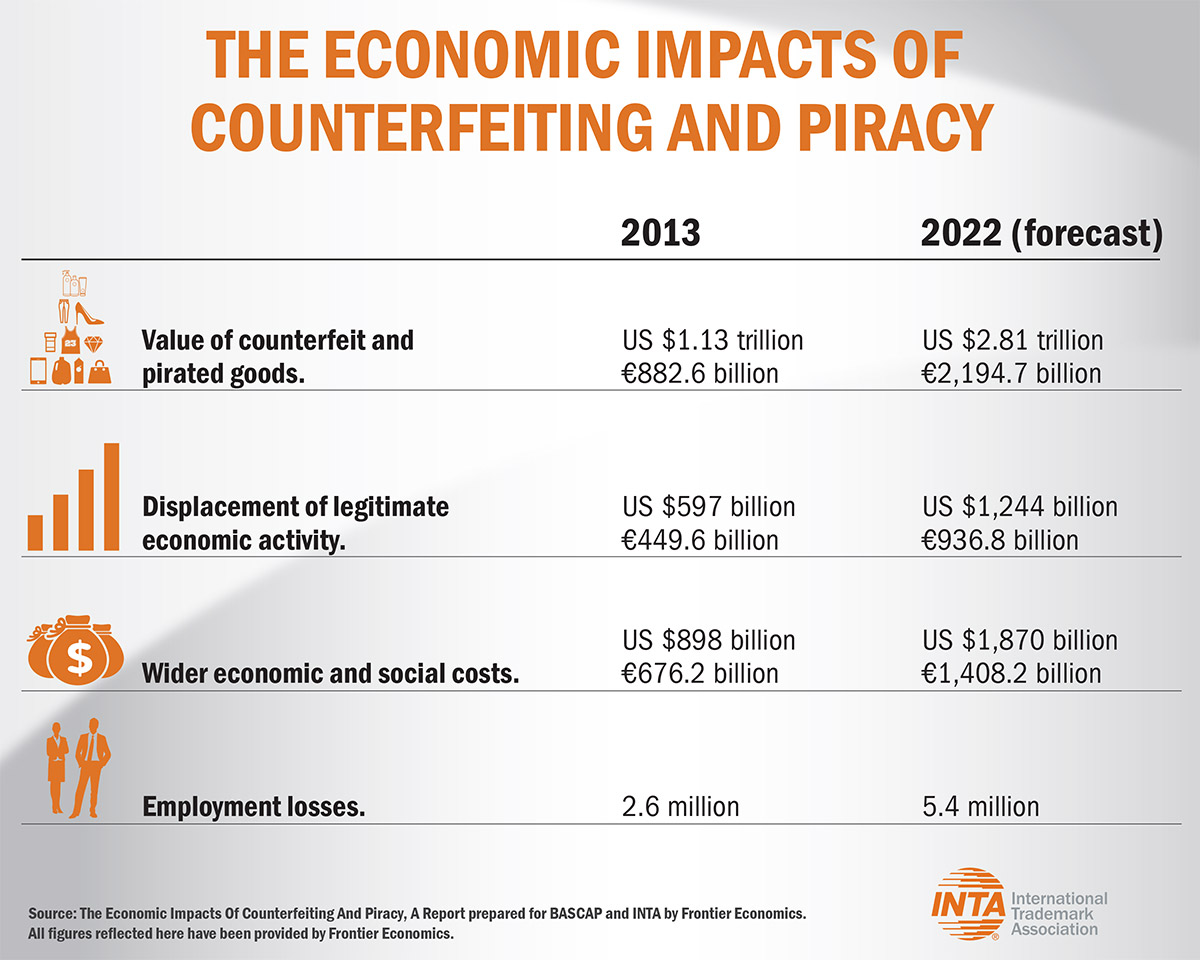G20 Executive Talk Series

Branded Story / International Trademark Association
Governments and Business Need to Work Together to Support Trademarks
Trademarks play a crucial role in today’s globalized economy, as businesses increasingly trade across borders, marketers become more sophisticated in the ways in which they communicate, and consumers grow more aware of brands. In fact, trademarks are the most popular form of intellectual property (IP) rights worldwide: According to the most recent figures compiled by the World Intellectual Property Organization (WIPO) and published in World Intellectual Property Indicators 2017, there were an estimated seven million trademark applications filed worldwide in 2016, an increase of 16.3 percent compared to the previous year and 300 percent more than the number filed in 2001 The total number of active trademark registrations around the world exceeded 39 million in 2016. Readers will readily bring to mind global brands, owned by large corporations that depend on trademarks to protect their names, logos, product configurations, or packaging shapes, but it is worth remembering that many trademarks are owned by small and medium-sized enterprises that do not yet have the same global reach. Moreover, trademarks can be tools for companies in established markets as well as those in emerging markets. For example, each year since 2010, China has accounted for between 50 percent and 85 percent of annual growth in trademark applications, according to the World Intellectual Property Indicators report. China leads the list of the top 20 trademark offices based on trademark class applications a list that also includes India, Iran, Vietnam, Brazil, Mexico, and Turkey.

Vital role of trademark rights
As these figures indicate, trademarks are playing a progressively more critical role in business. A trademark represents a guarantee to consumers that they are going to receive the goods or services they expect and that the customer experience will be familiar. This is increasingly important in a world where people trade and travel across borders, and order goods and services online.
The owners of trademark rights bear the primary responsibility for registering, maintaining, and upholding these important rights. But in today’s globalized world, trademarks face new or growing threats— dilution, counterfeits, online abuse, and brand restrictions, to name a few. In this environment, government of officials and legislators have an important role to play in providing a clear legislative and regulatory framework, making available appropriate remedies against trademark abuse, and promoting common legal standard— harmonization—between different jurisdictions.
There are many welcome initiatives in this regard. For example, WIPO offers centralized registration systems for trademarks, industrial designs, and patents. For trademarks, the Madrid System allows protection in one jurisdiction to be extended to up to 116 countries, including many of the world’s biggest markets, with relatively minimal cost and administrative burden. In 2017, the number of applications under the Madrid System grew for the eighth successive year, reaching 56,400—an annual increase of five percent.
On a practical level, there are many examples of cooperation between trademark of offices. The world’s five largest trademark and design of offices (covering China, the European Union, Japan, South Korea, and the United States) regularly exchange information, hold joint meetings, and collaborate on research projects under what is known as the TM5 framework. Organizations such as Europol and the World Customs Organization promote cooperation in enforcement, while the Internet Corporation for Assigned Names and Numbers (ICANN) has developed tools to tackle the serious challenges arising from cybersquatting and domain name abuse. But there is room for much more to be done, particularly as the business world faces new and accelerating challenges.
Why should governments play a role in supporting trademark rights?
Governments have a clear and growing interest in creating a favourable environment for the protection and enforcement of trademark rights
Studies have consistently shown that trademark rights support jobs, promote growth, and contribute to gross domestic product (GDP). A 2016 report published by the European Union Intellectual Property Office and the European Patent Office found that trademark-intensive industries in Europe employed more than 65 million people directly and indirectly (30.3 percent of the workforce) and contributed E4.8 trillion to GDP (36 percent of total EU GDP). [A similar study by the United States Patent and Trademark Office (USPTO) in 2016 found that trademark-intensive industries in the United States accounted for 23.7 million jobs and 34.9 percent of GDP with US $6.1 trillion in value added in 2014.
![]() Studies have consistently shown that trademark rights support jobs, promote growth, and contribute to gross domestic product (GDP).
Studies have consistently shown that trademark rights support jobs, promote growth, and contribute to gross domestic product (GDP).![]()

The impact of trademarks is not, however, limited to developed economies. In fact, recent studies have emphasised the critical role that trademark rights play in emerging markets. In August 2017, INTA published a study on the economic contribution of trademark-intensive industries in Indonesia, Malaysia, the Philippines, Singapore, and Thailand, to coincide with the 50th anniversary of the Association of Southeast Asian Nations (ASEAN). Across the five countries, the direct contribution of trademark-intensive industries to GDP varied between 17 percent and 50 percent, indirect contribution to GDP ranged from 40 percent to 60 percent, and the share of the workforce working in trademark-intensive industries ranged from 13 percent to 29 percent of total employment. Trademark-intensive industries also contributed between 27 percent and 60 percent of each country’s share of exports.
A study conducted jointly by INTA and the Inter-American Intellectual Property Association (ASIPI) and published last year, looked at five Latin American countries (Chile, Colombia, Mexico, Panama, and Peru) and concluded that trademark-intensive industries generate 18.5 million jobs and US $2,390 in revenue per person per year, contributing between 10 percent and 21 percent to GDP. For every US $100 of exports, US $15 corresponds to trademark-intensive products. Impressive though these figures are, they would be even higher but for the damage caused by counterfeiting and piracy. Research has consistently shown that the sale of counterfeit goods around the world harms company profits and reputation, reduces tax revenues, and costs jobs. The most recent report commissioned by the International Chamber of Commerce’s Business Action to Stop Counterfeiting and Piracy (ICC BASCAP) and INTA found that “the scale of counterfeiting and piracy globally is large, that it has grown since previous estimates, and that this growth is expected to continue.” The report estimated that the value of international and domestic trade in counterfeit and pirated goods, including digital piracy, will reach between US $1.9 trillion and US $2.81 trillion by 2022. This equates to economic losses of US $1.54 trillion to US $1.87 trillion, and job losses of 4.2 million to 5.4 million.

What can governments do?
There are a number of meaningful actions that governments can take to improve the global environment for trademark rights, providing greater business certainty and improved customer experiences while contributing to economic growth.
First, trademark harmonization can help to create consistency and clarity of rights. INTA has long supported efforts towards harmonization, such as the Madrid System. Recent accessions to the System, including by Indonesia, Mexico, and Thailand, are very welcome. It is particularly positive that all the ASEAN member states are committed to joining Madrid.
![]() Effective trademark protection is vital to ensure that these benefits are realized, and that customers are getting the goods and services they expect when they see a familiar name, logo, or packaging.
Effective trademark protection is vital to ensure that these benefits are realized, and that customers are getting the goods and services they expect when they see a familiar name, logo, or packaging. ![]()
Second, cooperation on a practical level—both between public and private sectors and between official bodies—helps to reduce obstacles to effective trademark protection and enforcement. Examples of this include the development of IT tools, databases, and training. Such efforts can be undertaken while respecting the differences in national laws and the independence of official agencies.
Third, further research is needed on the impact of trademarks and IP rights on brand equity and brand value. While much work has been done on this in recent years, there is considerable scope for further study, and the INTA Board recently established a Brand Value Special Task Force to provide a set of recommendations and actions on this topic.
Fourth, any legislation that impacts brand owners’ rights to use their trademarks should be carefully evaluated. For example, laws requiring plain packaging or other brand restrictions for tobacco products, food, alcohol, pharmaceuticals, or any other goods or services, must consider protection of IP rights alongside other public policy factors, such as their impact on public health.
Fifth, when significant political or economic changes are underway or anticipated, full consideration should be given to the impact of these changes on existing and future IP rights. For example, the changes resulting from Brexit raise many fundamental questions regarding EU trademarks and registered Community designs in the United Kingdom, as well ae s other IP issues. In November 2017, the INTA Board of Directors published a position paper emphasizing that the Brexit negotiations should be guided by the “general principles of minimum disruption, minimum cost, and maximum retention of rights.” These principles are vital for businesses, consumers, and legal practitioners.

Sixth, new obstacles to trademark protection and enforcement must be addressed. In particular, the threat of brand abuse on the Internet, social media, and mobile communication must be monitored and dealt with. In this context, INTA is concerned about changes to the availability of domain name registration data through the WHOIS system, caused by the uncertainties surrounding the new privacy obligations in the European General Data Protection Regulation (GDPR). This threatens the vast majority of the information used today to conduct trademark enforcement investigations, to send cease and desist letters, and to prepare complaints. ICANN has proposed an Interim Compliance Model that includes contemplates a limited amount of publicly available information with the rest behind a layered access model the required accreditation. A workable accreditation system is unlikely to be ready for many months. Governments, law enforcement, and regulatory agencies in many countries recognize the vital role played by WHOIS and may be able to help preserve parts of the current system and put in place effective mechanisms for the future. Given the importance of this issue and the May 25, 2018 effective date of the GDPR, urgent action to address this issue is required. Action could include ongoing dialog and obtaining clarification from data protection authorities about the impact of the GDPR on WHOIS; working with government representatives and law enforcement agencies seeking to preserve as much of the open, accessible WHOIS as possible; building an agreed accreditation system and WHOIS Purpose Statement that satisfies the requirements of GDPR; and raising concerns about the proposed interim model directly with ICANN.
There are instances of governments, professional associations, and businesses working effectively together to promote knowledge and education of trademarks—and more would be welcome. A few examples of this are the Congressional Trademark Caucus in the United States, which supports the role trademarks play in the economy by holding briefings, taking testimony from organizations such as INTA, and providing education; an IP awareness and education campaign initiated by the government of India as part of its National IPR Policy and carried out with assistance from INTA to educate school children; and INTA’s own Unreal Campaign, which involves collaboration with brand professionals and educational institutions to raise awareness among teens of the value of IP and the dangers of counterfeit goods and service.
Widespread benefits
The globalization of commerce, the development of free trade agreements, and the growing use of cyberspace for buying and selling products and services offer enormous benefits to today’s ever more sophisticated consumers. Effective trademark protection is vital to ensure that these benefits are realized, and that customers are getting the goods and services they expect when they see a familiar name, logo, or packaging. If the right policies and strategies are adopted and followed, these benefits will also extend to innovative businesses and to society more generally. This is something that can be achieved if governments, trademark owners, consumer groups, and others all work together.
